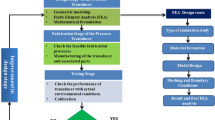Abstract
An analysis of gross pressure effect for strain gages is presented. This is defined as the difference between the predicted hydrostatic strain and the experimental strain. Values of the theoretical strain per unit pressure are based on the Voigt-Reuss-Hill approximation using published values of elastic moduli and compliances. These theoretical values are adjusted by the pressure effect calculated from an equation based on the assumption that the pressure effect is independent of the elastic properties of the substrate. The modified values of theoretical strain per unit pressure are then compared with the experimentally observed values. The differences are small except for the substrate materials of zinc, cadmium and lead.
Experimental pressure-strain data are presented for constantan foil gages mounted on tungsten, copper, tin, molybdenum, titanium, cadmium, brass, zinc and lead as well as constantan wire gages mounted on steel, aluminum and magnesium for hydrostatic pressures up to 140 ksi. Data for foil and wire gages mounted with various adhesives are presented and show that the adhesive or backing materials appear to have a relatively minor effect on the over-all gage performance.
Similar content being viewed by others
Abbreviations
- E :
-
modulus of elasticity(F/L 2)
- ν:
-
Poisson's ratio
- ε:
-
uniaxial engineering strain
- R :
-
resistance (ohms)
- ρ:
-
resistivity
- β:
-
linear compressibility of the gage grid materia
- GF m :
-
(‡R/R)/(‡L/L)=gage factor for bonded gage subjected to uniaxial strain
- SF β :
-
strain-sensitivity factor for unbacked gage subjected to hydrostatic pressure
- m 11,m 12 :
-
elastoresistivity coefficients
- K :
-
bulk modulus (F/L 2)
- K v ,K R :
-
Voigt and Reuss compressibilities (F/L 2)
- K VRH :
-
Voigt-Reuss-Hill compressibility (F/L 2)
- C ij :
-
elastic moduli (F/L 2)
- S ij :
-
elastic compliances (L 2/F)
- k T :
-
theoretical strain (per unit pressure);k T=f(C ij ) (F/L 2) org(S ij ) (L 2/F)
- k D :
-
pressure effect (indicated strain per unit pressureL 2/F)
- k T * :
-
theoretical strain (per unit pressure) adjusted for pressure effect
- k E :
-
experimental strain (per unit pressure) (L 2/F)
- k ‡ρ :
-
strain (per unit pressure) due to change in resistivity of the strain-gage grid with pressure (L 2/F)
- k ‡β :
-
strain (per unit pressure) due to change in dimensions of the strain-gage grid with pressure (L 2/F)
References
Milligan, R. V., “The Effects of High Pressure on Foil Strain Gages,”Experimental mechanics,4 (2),25–36 (1964).
Milligan, R. V., “The Effects of High Pressure on Foil Strain Gages on Convex and Concave Surfaces,”Ibid.,5 (2),59–64 (1965).
Brace, W.F., “On the Effect of Pressure on Electric-resistance Strain Gages,”Ibid.,,4, (7),212–216 (1964).
Bridgman, P. W., “Effects of Pressure on Binary Alloys, V; Fifteen Alloys of Metals of Moderately High Melting Point,”Proc. Am. Acad. Arts Sci.,84,131–177 (1957).
Bridgman, P. W., “The Effect of Tension on the Transverse and Longitudinal Resistance of Metals,”Ibid.,60,443–449 (1925).
Kuczynski, G. C., “Effect of Elastic Strain on the Electrical Resistance of Metals,”Phys. Rev.,94 (1),61–64 (April 1954).
Boas, W., and Mackenzie, F. K., “Anisotropy in Metals.” Prog. Metal Phys., II, Interscience Publishers, 1950.
Hearmon, R. F. S., “An Introduction to Applied Anisotropic Elasticity,” Oxford University Press, 1961.
Anderson, O. W., Compendium of Elastic Constants from the paper “A Simplified Method for Calculating the Debye Temperature from Elastic Constants”, Jnl. Phys. Chem. Solids,24,909–917 (1963).
Fisher, E. S., andRenken, C. J., “Single-Crystal Elastic Moduli and the hep → bcc Transformation in Ti, Zr and Hf,”Phys. Rev.,135 (2A),A482-A494 (July 1964).
Slutsky, L. J., andGarland, C. W., “Elastic Constants of Mg from 4.2° K to 300° K,”Ibid.,107 (4),972–976 (1957).
Long, T. R., andSmith, C. S., “Single Crystal Elastic Constants of Magnesium and Magnesium Alloys,”Acta Met.,5,200–207 (April 1957).
Goens, E., andSchmid, E., “Bestimmung Einiger Physikalischer Eignschaften von Magnesium Kristalle,”Naturwissenschaften,19,376–377 (1931).
Author information
Authors and Affiliations
Rights and permissions
About this article
Cite this article
Milligan, R.V. The gross hydrostatic-pressure effect as related to foil and wire strain gages. Experimental Mechanics 7, 67–74 (1967). https://doi.org/10.1007/BF02326709
Issue Date:
DOI: https://doi.org/10.1007/BF02326709




